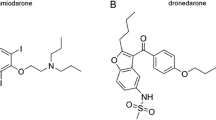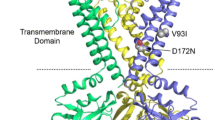Abstract
Ajmaline is a class Ia anti-arrhythmic drug used in several European countries and Japan as first-line treatment for ventricular tachyarrhythmia. Ajmaline has been reported to induce cardiac output (QT) prolongation and to inhibit cardiac potassium currents in guinea pig cardiomyocytes. In order to elucidate the molecular basis of these effects, we examined effects of ajmaline on human ether a-go-go related gene HERG potassium channels. Electrophysiological experiments were performed with human embryonic kidney (HEK) cells (whole-cell patch clamp) and Xenopus oocytes (double-electrode voltage clamp) expressing wild-type and mutant HERG channels. Ajmaline blocked HERG currents with an IC50 of 1.0 μmol/l in HEK cells and 42.3 μmol/l in Xenopus oocytes. The onset of block was fast and reached steady-state conditions after 180 s. The inhibitory effect was completely reversible upon wash-out. In HERG mutant channels Y652A and F656A lacking aromatic residues in the S6 domain, the inhibitory effect of ajmaline was completely abolished. Ajmaline induced a small shift in HERG current half-maximal activation voltage towards more negative potentials. Ajmaline did not markedly affect HERG inactivation. Inhibitory effects were not voltage-dependent. Ajmaline block exhibited positive frequency dependence. Ajmaline blocked HERG channels in the open, but not in the closed states. Binding of ajmaline to inactivated HERG channels may also be possible. In inactivation-deficient HERG S620T channels, the sensitivity to ajmaline was markedly reduced. The IC50 of HERG channel blockade in HEK cells lies within the range of unbound therapeutic plasma concentrations of ajmaline. Therefore, inhibitory effects on HERG channels may contribute to both the high anti-arrhythmic efficacy of ajmaline and to its pro-arrhythmic potential.











Similar content being viewed by others
References
Arias C, Gonzalez T, Moreno I, Caballero R, Delpon E, Tamargo J, Valenzuela C (2003) Effects of propafenone and its main metabolite, 5-hydroxypropafenone, on HERG channels. Cardiovasc Res 57:660–669
Bahnikowa M, Matejovic P, Pasek M, Simurdova M, Simurda J (2002) Ajmaline-induced block of sodium current in rat ventricular myocytes. Scr Med (Brno) 75:169–178
Bouffard Y, Roux H, Perrot D, Ducluzeau R, Page Y, Lehot JJ, Bonletreau P, Motin J (1983) Acute ajmaline poisoning. Study of seven cases. Arch Mal Coeur Vaiss 76:771–777
Brugada J, Brugada P (1996) What to do in patients with no structural heart disease and sudden arrhythmic death. Am J Cardiol 78:69–75
Brugada R, Brugada J, Antzelevitch C, Kirsch GE, Potenza D, Towbin JA, Brugada P (2000) Sodium channel blockers identify risk for sudden death in patients with ST-segment elevation and right bundle branch block but structurally normal hearts. Circulation 101:510–515
Bussmann WD, Schreiber S, Kaltenbach M (1980) Comparison of antiarrhythmic effects of oral prajmalium bitartrate and intravenous lidocaine in acute myocardial infarction. Am Heart J 99:589–597
Chen X, Borggrefe M, Martinez-Rubio A, Hief C, Haverkamp W, Hindricks G, Breithardt G (1994) Efficacy of ajmaline and propafenone in patients with accessory pathways: a prospective randomized study. J Cardiovasc Pharmacol 24:664–669
Enomoto K, Imoto M, Nagashima R, Kaneko T, Maruyama T, Kaji Y, Tsuda Y, Kanaya S, Fujino T, Niho Y (1995) Effects of ajmaline on non-sodium ionic currents in guinea-pig ventricular myocytes. Jpn Heart J 36:465–476
Eshchar Y, Belhassen B, Laniardo S (1986) Comparison of exercise and ajmaline tests with electrophysiologic study in the Wolff–Parkinson–White syndrome. Am J Cardiol 57:782–786
Fernandez D, Ghanta A, Kauffman G, Sanguinetti M (2004) Physical chemical features of the HERG channel drug binding site. J Biol Chem 279:10120–10127
Ficker E, Jarolimek W, Kiehn J, Baumann A, Brown AM (1998) Molecular determinants of dofetilide block of HERG K+ channels. Circ Res 82:386–395
Haverkamp W, Mönnig G, Kirchhof P, Eckhardt L, Borggrefe M, Breithardt G (1995) Torsade de pointes induced by ajmaline. Z Kardiol 90:586–590
Kaul U, Mohan JC, Narula J, Nath CS, Bhatia ML (1985) Ajmaline-induced torsade de pointes. Cardiology 72:140–143
Khalilullah M, Sathyamurthy I, Singhal NK (1980) Ajmaline in WPW syndrome: an electrophysiologic study. Am Heart J 99:766–771
Kiehn J, Lacerda A, Brown AM (1999a) Pathways of HERG inactivation. Am J Physiol 277:H199–H210
Kiehn J, Thomas D, Karle CA, Schöls W, Kübler W (1999b) Inhibitory effects of the class III antiarrythmic drug amiodarone on cloned HERG potassium channels. Naunyn-Schmiedebergs Arch Pharmacol 359:212–219
Kolard J, Humhal J, Karetova D, Novak M (1987) Torsade de pointes after mesocaine and ajmaline in a patient with intermittent atrioventricular block. Favourable therapeutic effect of high doses of isoprenaline. Cas Lek Cesk 126:1503–1507
Köppel C, Wagemann A, Martens F (1989) Pharmacokinetics and antiarrhythmic efficacy of intravenous ajmaline in ventricular arrhythmia of acute onset. Eur J Drug Metab Pharmacokinet 14:161–167
Körper S, Wink M, Fink RHA (1998) Differential effects of alkaloids on sodium currents of isolated single skeletal muscle fibres. FEBS Lett 436:251–255
Madeja M, Musshoff U, Speckmann EJ (1997) Follicular tissues reduce drug effects on ion channels in oocytes of Xenopus laevis. Eur J Neurosci 9:599–604
Manz M, Mletcko R, Jung W, Luderitz B (1992) Electrophysiological and haemodynamic effects of lidocaine and ajmaline in the management of sustained ventricular tachycardia. Eur Heart J 13:1123–1128
Mergenthaler J, Haverkamp W, Hüttenhofer A, Skryabin BV, Musshoff U, Borggrefe M, Speckmann EJ, Breithardt G, Madeja M (2001) Blocking effects of the antiarrhythmic drug propafenone on the HERG potassium channel. Naunyn-Schmiedebergs Arch Pharmacol 363:472–480
Mitcheson JS, Chen J, Lin M, Culberson C, Sanguinetti MC (2000a) A structural basis for drug-induced long QT syndrome. Proc Natl Acad Sci USA 97:12329–12333
Mitcheson JS, Chen J, Sanguinetti MC (2000b) Trapping of a methanesulfonanilide by closure of the HERG potassium channel activation gate. J Gen Physiol 115:229–240
Padrini R, Piovan D, Javarnaro A, Cucchini F, Ferrari M (1993) Pharmacokinetics and electrophysiological effects of intravenous ajmaline. Clin Pharmacokinet 25:408–414
Paul AA, Witchel HJ, Hancox JC (2001) Inhibition of HERG potassium channel current by the class 1a antiarrhythmic agent disopyramide. Biochem Biophys Res Commun 280:1243–1250
Paul AA, Witchel HJ, Hancox JC (2002) Inhibition of the current of heterologously expressed HERG potassium channels by flecainide and comparison with quinidine, propafenone and lignocaine. Br J Pharmacol 136:717–729
Pearlstein RA, Vaz RJ, Kang J, Chen XL, Preobrazhenskaya M, Shchekotikhin AE, Korolev AM, Lysenkova LN, Miroshnikova OV, Hendrix J, Rampe D (2003) Characterization of HERG potassium channel inhibition using CoMSiA 3D QSAR and homology modelling approaches. Bioorg Med Chem Lett 13:1829–1835
Redfern WS, Carlsson L, Davis AS, Lynch WG, MacKenzie J, Palethorpe S, Siegl PK, Strang I, Sullivan AT, Wallis R, Camm AJ, Hammond TG (2003) Relationships between preclinical cardiac electrophysiology, clinical QT interval prolongation and torsade de pointes for a broad range of drugs: evidence for a provisional safety margin in drug development. Cardiovasc Res 58:32–45
Ridley JM, Milnes JT, Benest AV, Masters JD, Witchel HJ, Hancox JC (2003) Characterisation of recombinant HERG K+ channel blockade by the class Ia antiarrhythmic drug procainamide. Biochem Biophys Res Commun 306:388–393
Roden DM, Balser JR, George AL Jr, Anderson ME (2002) Cardiac ion channels. Annu Rev Physiol 64:431–475
Sanchez-Chapula JA, Navarro-Polanco RA, Culberson C, Chen J, Sanguinetti MC (2002) Molecular determinants of voltage-dependent human ether-a-gogo related gene (HERG) K+ channel block. J Biol Chem 277:23587–23595
Sanchez-Chapula JA, Ferrer T, Navarro-Polanco RA, Sanguinetti MC (2003) Voltage dependent profile of human ether-a-gogo-related gene channel block is influenced by a single residue in the S6 transmembrane domain. Mol Pharmacol 63:1051–1058
Schmitt C, Brachmann J, Schols W, Beyer T, Kübler W (1989) Proarrhythmic effect of ajmaline in idiopathic ventricular tachycardia. Dtsch Med Wochenschr 114:99–102
Scholz EP, Zitron E, Kiesecker C, Lueck S, Kathofer S, Thomas D, Weretka S, Peth S, Kreye VA, Schoels W, Katus HA, Kiehn J, Karle CA (2003) Drug binding to aromatic residues in the HERG channel pore cavity as possible explanation for acquired Long QT syndrome by antiparkinsonian drug budipine. Naunyn-Schmiedebergs Arch Pharmacol 368:404–414
Spector PS, Curran ME, Keating MT, Sanguinetti MC (1996) Class III antiarrhythmic drugs block HERG, human cardiac delayed rectifier K+ channel. Open channel block by methanesulfonanilides. Circ Res 78:499–503
Thomas D, Wendt-Nordahl G, Rockl K, Ficker E, Brown AM, Kiehn J (2001) High-affinity blockade of human ether-a-go-go-related gene human cardiac potassium channels by the novel antiarrhythmic drug BRL-32872. J Pharmacol Exp Ther 297:753–761
Thomas D, Gut B, Wendt-Nordahl G, Kiehn J (2002) The antidepressant drug fluoxetine is an inhibitor of human ether-a-go-go-related gene (HERG) potassium channels. J Pharmacol Exp Ther 300:543–548
Wellens HJ, Durrer D (1974) Effect of procainamide, quinidine and ajmaline in the Wolff–Parkinson–White syndrome. Circulation 50:114–121
Wilde AA, Antzelevitch C, Borggrefe M, Brugada J, Brugada R, Brugada P, Corrado D, Hauer RN, Kass RS, Nademanee K, Priori SG, Towbin JA (2002) Proposed diagnostic criteria for the Brugada syndrome (consensus report). Eur Heart J 23:1648–1654
Zitron E, Karle CA, Wendt-Nordahl G, Kathofer S, Zhang W, Thomas D, Weretka S, Kiehn J (2002) Bertosamil blocks HERG potassium channels in their open and inactivated states. Br J Pharmacol 137:221–228
Acknowledgements
This work was supported by grants from the Deutsche Forschungsgemeinschaft Ki 663/1-1 to Dr Kiehn and Ka 1714/1-1 to Dr Karle, and by grants from the Novartis-Foundation, from the University of Heidelberg (“AIP+F”) and from the Foundation Cardiology 2000 (Forssman-Scholarship) to Dr Thomas. E. Zitron was supported by the German National Academic Foundation. Data presented here are part of the thesis of C. Kiesecker.
Author information
Authors and Affiliations
Corresponding author
Rights and permissions
About this article
Cite this article
Kiesecker, C., Zitron, E., Lück, S. et al. Class Ia anti-arrhythmic drug ajmaline blocks HERG potassium channels: mode of action. Naunyn-Schmiedeberg's Arch Pharmacol 370, 423–435 (2004). https://doi.org/10.1007/s00210-004-0976-8
Received:
Accepted:
Published:
Issue Date:
DOI: https://doi.org/10.1007/s00210-004-0976-8




